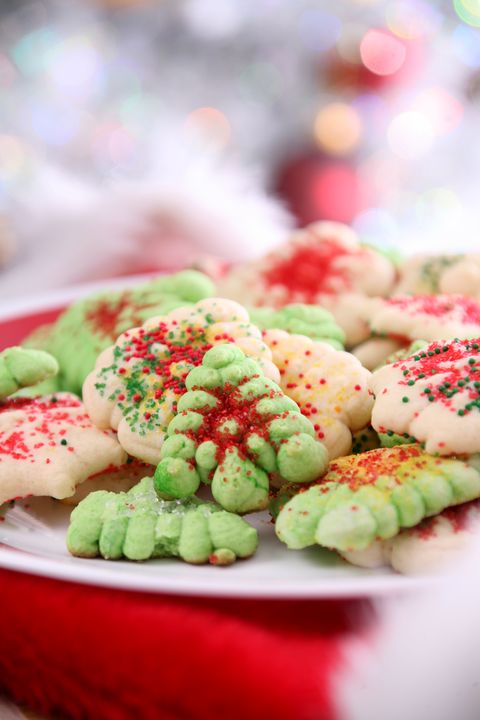Spritz cookies are a holiday staple for many thanks to their delicious taste and fun appearance. They are essentially butter cookies made with a cookie press, which makes it easier to create the cutest holiday designs. Although many cultures have various versions of these where did they originate?
Spritz cookies originate from Scandinavian countries, where they are a traditional Christmas cookies. The name comes from the German word spritzen, which means "to squirt." One Norwegian tradition is to make them in the shapes of S's and O's, but today, they're often made into Christmas trees, stars, and more. 
These cookie have actually been around since the mid 1700s, when they were created by German Protestant Settlers in Nazareth, Pennsylvania. They became known as Nazareth Cookies, and they were so good that they were eventually recognized as Pennsylvania's official cookie by the Commonwealth of Pennsylvania. Their simplicity made them extremely popular for kids to make and leave out for Santa Claus.
Sugar Cookies

These treats might not technically qualify as cookies (they're basically layers of sponge cake with chocolate frosting and a jelly filling), but they're delicious, and a lasting tradition this time of year. They are typically made of three layers of red, green, and white sponge cake. According to Italian Sons and Daughters of America, many people believe that rainbow cookies are an Italian-American recipe, something created to honor the Italian flag by Italian-American bakers
ITALIAN RAINBOW COOKIES

Also known as pine nut cookies, these are pretty simple: they're generally made with almond paste, sugar, and pine nuts. Because they are made with an almond paste, they are actually considered to be a type of macaroon. Many speculate they're from Sicily where almond paste is popular.

PIGNOLI COOKIES
Molasses cookies are similar to gingerbread cookies: sweet, spiced, with a nice flavor that just reminds you of the holidays. While it's not really known exactly where they came from, we do know that molasses was often used in place of this ingredient.

Sugar
Gingerbread men are a holiday classic. They date back to this former ruler. During that time, the royal family was known for elaborate dinners and this ruler also had a royal gingerbread maker who created gingerbread men to represent foreign dignitaries and people in her court. At the same time, folk-medicine practitioners, AKA witches and magicians, prescribed them as "love tokens" for young women to help men fall in love with them.
Queen Elizabeth I

These cookies have been around since the 1850s, with Dutch and German origins. In Dutch, they're also called pepernoten, and they are linked to the December feast of Sinterklaas in The Netherlands. The word means "pepper nuts," and although the cookies are not made with nuts, they were traditionally not much bigger than them. 
PFEFFERNUSSE
These cookies are also known as Danish cookies, Brysslkex and Sablés, and in some parts of their world, they are thought of as biscuits rather than cookies. In much of Europe and North America, butter cookies are served with afternoon tea. Today, they are a traditional holiday cookie, and they are often decorated to look more festive.
BUTTER COOKIES

While gingerbread men are usually on the softer side, gingersnaps are usually more thin and crunchy. In fact, that's where the name comes from — the sound they make when you eat them. Gingerbread has a very long history, with traditions in these four countries name them. (100 pts for each country) 
Germany, France, Netherlands, England
A whoopie pie is basically a cookie sandwich. A creamy vanilla filling is smashed between two cake-like chocolate cookies (although now there are many, many flavors available), and they are a rich dessert that flourish during the holiday season. These two US States are in a constant arguement over where they orginated. (100 pts for each state)
Pennsylvania and Maine
Some say that the cookie originated in Maine in 1925, when Labadie's Bakery began selling them, saying they were the first to do so. But there's no proof: all of the documents of the bakery were destroyed in a fire. Others say they were first created in Pennsylvania Dutch Country, with a recipe handed down through generations. Amish cooks supposedly made the first whoopies using leftover cake batter, and legend says the children used to shout "whoopie!" when they would eat them.
These cookies are thin, waffle-like cookies that are a beloved Italian holiday tradition. They are light, delicate, and taste much like the waffle cone at an ice cream shop.
Pizzelle

A snickerdoodle is often considered a variation on a sugar cookie, as it has essentially the same base, but is rolled in cinnamon sugar instead of just sugar. They're sweet with a kick of warm cinnamon, and they're delicious with coffee or a cold glass of milk. Their origin was widely debated, name one of the two countries they are believed to come from
German or Dutch

These cookies are also known as hallongrotta, which means "raspberry cave" in Swedish. They have also been called bird's nest cookies, butterballs, or Polish tea cakes, and they are believed to have originated in the 19th century. It's unclear where they came from.

THUMBPRINTS
While these cookies are now known to be an Italian treat that pops up even mroe during the holiday it is that they originated during Roman times. They were a convenience food for travelers, not a dessert treat, because they were so hard and durable that they could last quite a while. during the Renaissance, they re-emerged in Tuscany thanks to a baker who served them with sweet wine. As they became more popular, they spread throughout Italy (where they are often called "cantucci"), and eventually made their way to the U.S. What cookies are these?
BISCOTTI 
Lebkuchen is a traditional German Christmas treat, and is basically Germany's version of a this cookie. These heart-shaped cookies are hugely popular in German Christmas markets, where they are often frosted and decorated. It is sometimes referred to as "honey cake."

Viennese crescent cookies are typically hard, almond-flavored cookies covered in sweet, powdered sugar. Some argue that these cookies are actually what croissants were based off of, which would make sense considering their shape. Where did these originate?
Austria - and came out of a celebration of Austrian victory over the Ottomans at the siege of Vienna.

These cookies are made of an almond dough with a sweet jelly filling inside, and they are definitely a holiday favorite. These cookies originated in the town of Linz in Austria many years ago. They are traditionally comprised of a buttery dough made of almonds, lemon zest, and cinnamon, and filled with black currant preserves. In America, raspberry replaced the black currants, which is how many of us eat them.
LINZER COOKIES

If you aren't making and eating chocolate crinkle cookies during the holidays, you're doing it wrong. These soft, chewy cookies have a great flavor without being overwhelmingly chocolatey, and they are super easy to make. Not a lot is known about where these cookies came from, although it is believed they were a popular item in this country.

Philippines
These cookies are festive, delicious, and just seem like a reminder of the holidays no matter where you are. The only thing is that it's hard to pin down where they came from, or even a basic recipe, because it's different all over the world. They are also known as Russian tea cakes, Mexican wedding cookies, Italian cookies, or butterballs. What is their most populat name? 
Snowball Cookies
According to The New Yorker, chocolate chip cookies were invented by Ruth Wakefield in the 1930s. Wakefield ran the popular Toll House restaurant in Whitman, Massachusetts with her husband, Kenneth, and that is where the cookies were bon. Wakefield famously sold the rights to her cookie recipe and the Toll House name to Nestle in 1939 for this price. She later said she never received this amount.
$1

These cookies are always a popular treat in France, but here in the U.S., you really start to see more of them during the holiday season. It is believed that they originated in the 20th century in France, and that they may have been adopted from a Middle Eastern method of layering thin sheets of pastry. What is the name of this cookie? 
CHOCOLATE PALMIERS
Shortbread cookies are basically a more crumbly, melt-in-your-mouth version of a sugar cookie or butter cookie. They're sweet, sometimes made with other spices, and have been around a very long time, first originating in what country?

Scottland
Scottish shortbread evolved from medieval biscuit bread, which was usually any leftover dough dried out in a low oven. At some point, the yeast in the bread was replaced with sugar, and that bread became shortbread.
These cookies almost taste like tiny cakes rather than cookies, but they're still a holiday tradition. While they may pop up the most around the holidays in the U.S., they are a very popular treat in France throughout most of the year, and have been since the 17th century. 
MADELEINE COOKIES
Peanut butter cookies are another simple holiday favorite, made with a basic dough and peanut butter, then flattened and pressed with a fork to produce the telltale fork signs you'll almost always notice on them. It's unclear exactly where peanut butter cookies came from, although many believe they first appeared during the 19th century. One belief of their origin is from an article in Popular Science News, that suggested Peanut Butter could be a substitution for this ingredient.
Butter or Shortening

Seven layer bars are an over-the-top cookie filled with so many different treats: candies, chocolate, nuts, coconut, and more. These bars are also sometimes another nickname originating fromm this popular Broadway show in 1965.

Hello Dolly - their nickname is Hello Dolly Bars and they were based off a Hello Dolly Cake published in a food column in The Week magazine.